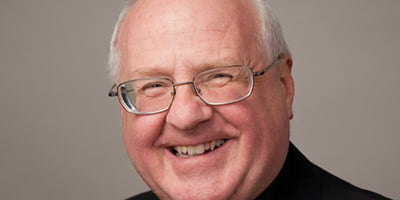
Father Mark Goldasich is the pastor of Sacred Heart parish in Tonganoxie. he has been editor of the Leaven since 1989.
by Father Mark Goldasich
Sometimes as I’m walking, I wonder if they wonder what I’m doing.
The “they” are the people driving on Parallel Parkway, around 126th Street, during afternoon working hours, particularly on Mondays or Fridays. There are two places there — Savior Pastoral Center on the southwest corner; Gate of Heaven Cemetery on the northwest corner — that attract attention. My walking around the pastoral center shouldn’t give people pause. It’s my wandering through the cemetery that might draw some attention.
Truth is, I like to walk around Gate of Heaven. Especially on those days when my mind is jumbled or my nerves jangled or my patience thin, there’s nothing to put things into perspective like a good walk in the cemetery.
With Halloween just passed, let me reassure everyone that in all of the times that I’ve strolled through the cemetery, never once have the dead tried to scare or bother me. I’ve never been chased by anyone rising from their grave and no dead person has ever tried to pounce on me to devour my flesh. It’s a very peaceful place.
This issue of The Leaven comes out on the feast of All Souls. Actually, the whole month of November is directed to remembering those who have died. It’s not meant to be a fearful or morbid time, but rather a month to recall the tremendous resource that’s available to us in our journey of faith: the communion of saints. Rather than running from the dead as horror movies would have us do, we’re to run toward them instead, especially in times of need.
A recent book by Sister Janice McGrane, SSJ, captures this sentiment nicely. It’s entitled, “Saints to Lean On: Spiritual Companions for Illness and Disability” (Cincinnati: St. Anthony Messenger Press, 2006; 167 pgs.; #13.95). Isn’t that a comforting image? When our energy — both spiritual and physical — is drained, we have these marvelous intercessors in heaven to rely on.
The book is divided into 11 chapters, each dealing with a particular saint and condition. Some are well-known and formally named saints, blesseds or venerables by the church, such as St. Ignatius Loyola or St. Therese of Lisieux. Others, though — Matt Talbot or Caryll Houselander — are simply wonderful companions, much like those good and holy deceased people from our own families or parishes, but not officially recognized by the church.
The author shows how these particular saints dealt with their illnesses and how they can be helpers for someone experiencing similar situations today. For example, those who have suffered a stroke can draw strength from Jesuit Father Pedro Arrupe; Sister Thea Bowman can inspire others to embrace “a joy-filled suffering”; caregivers can be guided by the example of St. Catherine of Genoa; and those with physical disfigurements can seek out Blessed Kateri Tekakwitha.
The refreshing thing about this book is that it not only draws on saints from centuries past, but also from people in the 20th century — even Americans like Sister Thea and Cardinal Joseph Bernardin.
This volume can help all of us appreciate the rich tradition we have in our veneration of the saints. And it may encourage us all — no matter what life deals us — to follow Sister Thea’s advice to “live until you die.”
If you’re still a bit queasy, though, when you pass a cemetery, let the following story alleviate your fears:
On the outskirts of a small town, there was a big, old pecan tree just inside the cemetery fence. One day, two boys filled up a bucketful of nuts and sat down by the tree, out of sight, and began dividing the nuts.
“One for you, one for me. One for you, one for me,” said one boy. Several dropped and rolled down toward the fence.
Meanwhile, another boy came riding along the road on his bicycle. As he passed the cemetery, he heard voices from inside saying, “One for you, one for me.”
He quickly rode off. Just around the bend he met an old man with a cane, shuffling along.
“Come here quick,” said the boy excitedly, “you won’t believe what I heard! Satan and the Lord are down at the cemetery dividing up the souls.”
The man said, “Beat it, kid, can’t you see it’s hard for me to walk?” When the boy insisted, though, the man hobbled slowly to the cemetery.
Standing by the fence they heard, “One for you, one for me.” The old man whispered, “Son, you’ve been tellin’ me the truth. Let’s see if we can see the Lord.”
Shaking with fear, they peered through the fence, trying hard to get a glimpse of the Lord.
At last they heard, “One for you, one for me. That’s all. Now let’s go get those nuts by the fence and we’ll be done.”
They say the old man made it back to town a full 5 minutes ahead of the kid on the bike.

